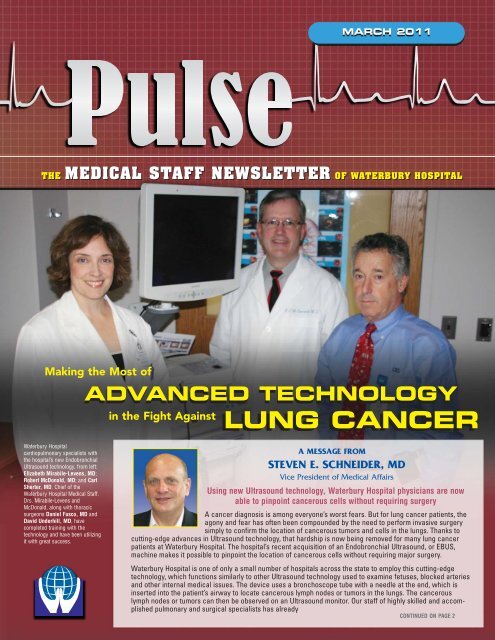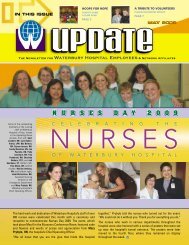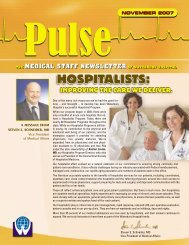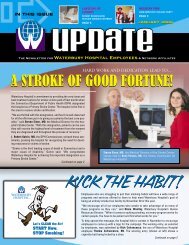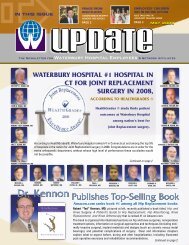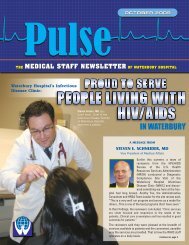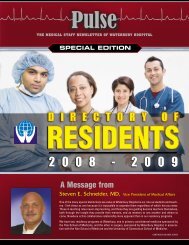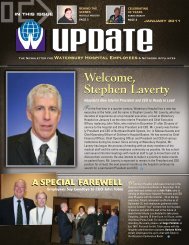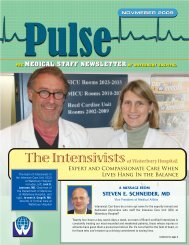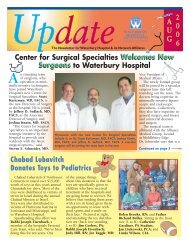March 2011 - Waterbury Hospital
March 2011 - Waterbury Hospital
March 2011 - Waterbury Hospital
- No tags were found...
Create successful ePaper yourself
Turn your PDF publications into a flip-book with our unique Google optimized e-Paper software.
MARCH <strong>2011</strong>THE MEDICAL STAFF NEWSLETTER OF WATERBURY HOSPITALMaking the Most ofADVANCED TECHNOLOGYin the Fight Against LUNG CANCER<strong>Waterbury</strong> <strong>Hospital</strong>cardiopulmonary specialists withthe hospital’s new EndobronchialUltrasound technology, from left:Elizabeth Mirabile-Levens, MD;Robert McDonald, MD; and CarlSherter, MD, Chief of the<strong>Waterbury</strong> <strong>Hospital</strong> Medical Staff.Drs. Mirabile-Levens andMcDonald, along with thoracicsurgeons Daniel Fusco, MD andDavid Underhill, MD, havecompleted training with thetechnology and have been utilizingit with great success.A MESSAGE FROMSTEVEN E. SCHNEIDER, MDVice President of Medical AffairsUsing new Ultrasound technology, <strong>Waterbury</strong> <strong>Hospital</strong> physicians are nowable to pinpoint cancerous cells without requiring surgeryA cancer diagnosis is among everyone’s worst fears. But for lung cancer patients, theagony and fear has often been compounded by the need to perform invasive surgerysimply to confirm the location of cancerous tumors and cells in the lungs. Thanks tocutting-edge advances in Ultrasound technology, that hardship is now being removed for many lung cancerpatients at <strong>Waterbury</strong> <strong>Hospital</strong>. The hospital’s recent acquisition of an Endobronchial Ultrasound, or EBUS,machine makes it possible to pinpoint the location of cancerous cells without requiring major surgery.<strong>Waterbury</strong> <strong>Hospital</strong> is one of only a small number of hospitals across the state to employ this cutting-edgetechnology, which functions similarly to other Ultrasound technology used to examine fetuses, blocked arteriesand other internal medical issues. The device uses a bronchoscope tube with a needle at the end, which isinserted into the patient’s airway to locate cancerous lymph nodes or tumors in the lungs. The cancerouslymph nodes or tumors can then be observed on an Ultrasound monitor. Our staff of highly skilled and accomplishedpulmonary and surgical specialists has alreadyCONTINUED ON PAGE 2
ADVANCEDTECHNOLOGYCONTINUED FROM PAGE 1used the EBUS device on more than adozen patients since it became operationalin December, and the results havebeen most encouraging.“Before we had this technology, wewould not have been able to identify thecancer as quickly and efficiently as weare now able to,” said Carl B. Sherter,MD, Chief of the Pulmonary Section at<strong>Waterbury</strong> <strong>Hospital</strong> and Chief of theMedical Staff. Two of the hospital’s pulmonaryspecialists, Robert McDonald,MD, and Elizabeth Mirabile-Levens, MD,have completed training on the EBUSmachine and have already used it toexamine several patients.The new technology has also proven tobe most welcome for hospital surgeonssuch as Daniel Fusco, MD, a thoracicsurgery specialistwho also hasbeen trained toutilize the EBUSmachine alongwith his colleague,DavidUnderhill, MD.“It’s an extremelyDaniel Fusco, MDconvenient andminimally invasiveway todetermine thestage of apatient’s lungcancer, which isa critical factorin determiningtreatment,” Dr.David Underhill, MDFusco said.Dr. Sherter said the technology is a complementarypiece to the hospital’s broadrange of services for the diagnosis andtreatment of lung cancer. Another recentlypurchased device allows physicians toisolate and examine individual layers ofcells to inspect for signs of cancer on acell-by-cell basis.We are very pleased to be able to offerthese kinds of services to our patients.Lung cancer is a very serious healthissue, which is why we are committed tousing the most advanced technology andthe most highly skilled doctors in theeffort to wipe it out.Steven E. Schneider, MDVice President of Medical AffairsA MESSAGE FROMSTEPHEN R. LAVERTYIn early January, Stephen R. Laverty assumed thetop leadership role at <strong>Waterbury</strong> <strong>Hospital</strong> as theInterim President and Chief Executive Officer,replacing former President and CEO John Tobin,who retired after 35 years with the hospital. Mr.Laverty was hired by the <strong>Waterbury</strong> <strong>Hospital</strong> Boardof Directors to fill the top executive position whilethe search continues for a permanent President andCEO. In this message distributed to the hospital community in early<strong>March</strong>, Mr. Laverty discusses the great fiscal challenges the hospital isfacing and the steps being taken to address them.TO THE EMPLOYEES AND PHYSICIANS OFWATERBURY HOSPITALI want to take this opportunity to update you on the work this is being done to address th fiscalchallenges our institution is facing.As I reported in an earlier message, we need to reduce our expenses by three to five percent– on an annualized basis - in the current fiscal year. I am pleased to report that we areapproximately one-third of the way to reaching our goal. We have more to do, but this is significantprogress in a short period of time.We began that process by eliminating some positions, mostly through attrition, but alsothrough some layoffs. I recognize that this can be a painful process; it is one that we did notundertake lightly. But the tough choices we make now will ultimately help ensure the stabilityof the hospital for the future.In my conversations with many of you, I heard clearly that in order to make the hospital amore efficient, convenient place for patients, medical staff, and employees, we needed tomake some policy and operational changes. I am pleased to report that thanks to your hardwork in many areas, we are making progress. To date, we have:• Amended the hospital’s attendance policyAfter hearing concerns that our policy was unnecessarily punitive, we have stoppedissuing disciplinary occurrences to employees who are no more than five minutes latefor the beginning of their shifts. In addition, we will no longer count the first four sickdays as an occurrence.I hope these and other changes to the attendance policy will alleviate some of the concernsraised by employees, but we also expect that these policies will not be abusedand that we will see a reduction in FMLA usage as a result. This is very important tomeeting our goals.• Made significant changes to parking for patients and medical staffIn response to concerns from physicians, we have created special stickers for theReed Lot, which are being distributed to clinicians who treat patients in the OR. Inaddition, we have set aside 30 spaces in the Doctor and Directors Lot for physicianswhose primary medical offices are located off hospital grounds.2CONTINUED ON PAGE 3
CONTINUED FROM PAGE 2• Increased Operating Room availabilityWe have made scheduling changes so that an additionalroom is now available for surgeons outside ofblock time Monday through Friday on a first-come,first-served basis. This gives our surgeons greaterflexibility to perform emergent procedures withoutrequiring significant advance notice. We have alsoincreased coordination between OR personnel andCentral Sterile to ensure the accuracy and availabilityof equipment.• Created up to 30 new private patientrooms on the Pomeroy floorsAfter months of renovations, additional patient roomshave opened up on Pomeroy 6, allowing us to significantlyincrease the number of private rooms availableto patients.• Undertaken several initiatives to promotecleanliness and repair broken equipmentWe have adjusted staff hours and responsibilities sothat more attention and supervision can be providedto keeping patient areas clean and functional. Wehave also established a hotline at Ext. 5299 (in-house)and (203) 228-9181 (external) for staff to report missingor broken equipment. Today, as I walk around the hospital,the halls are far less cluttered, and I want to letyou know how much I appreciate the work that hasgone into this initiative.This is just a small sample of the work that is underway tomake <strong>Waterbury</strong> <strong>Hospital</strong> a more attractive place forpatients and staff, restore patient volume, and enhanceadmissions.Also, I have accepted the resignations of Mary Prybylo, RN,Chief Operating Officer and Randy Essenberg, ChiefPerformance Improvement Officer. We appreciate their service,and wish them well in their new endeavors. We willkeep you updated on how we intend to allocate theirresponsibilities.I am aware that these are challenging times, but I am confidentthat these hard decisions will ensure our growth in theyears ahead.A recent article in the <strong>Waterbury</strong> Republican-American concerningthe financial situation at Saint Mary’s <strong>Hospital</strong>should give all of us confidence. In the story, Saint Mary’sattributed much of the hospital’s recent financial success tosome difficult decisions that were made six years ago whenthe hospital was facing deficits and layoffs.I believe that the efforts we make today will yield us similarresults in the future. The work proceeds, and we are veryhopeful that we will achieve financial success.In the meantime, please know that I am open to all questions,concerns or suggestions you may have about the hospital’soperations. We will continue to update you as plansunfold, and again, thank you all for your hard work at thischallenging time.IN THESPOTLIGHT:John Strugar, MDFinding Success byKeeping it SimpleNeurosurgeon takes a step-by-step approachto saving livesNo one would describe neurosurgery as a simple undertaking,but for <strong>Waterbury</strong> <strong>Hospital</strong> neurosurgeon John Strugar, MD, it’s importantto keep it as simple as possible.“Even with the most complex procedures, I try to break it down into simple, easysteps that I know are do-able,” said Dr. Strugar, a Romanian native who has over20 years of experience as a neurosurgeon. “If you try to do too much at once orthink too much about the overall procedure, that’s when things get dangerous.”Dr. Strugar’s “Keep It Simple” approach has served him extremely well over hiscareer, which includes 20 years as an attending neurosurgeon at Yale-New Haven<strong>Hospital</strong> and professor at the Yale School of Medicine. He is also widely recognizedas a specialist in spinal and skull-based neurosurgery, having completed afellowship in skull-based neurosurgery at George Washington University School ofMedicine. For the last three years, he has also been a member of NOSS:Neurosurgery, Orthopaedics & Spine Specialists, PC, a <strong>Waterbury</strong> practice affiliatedwith <strong>Waterbury</strong> <strong>Hospital</strong>.Dr. Strugar said he had considered joining other prestigious practices in Californiabut decided to join the <strong>Waterbury</strong> practice because of its reputation for excellence-- and for love. Earlier this year, he married Tamara Lazic, MD, a dermatologistin training, and they have settled into a home in the <strong>Waterbury</strong> area.“I’m very happy,” he said. “My colleagues and the clinical staff have all been verysupportive and kind. But my main satisfaction continues to be the work itself.”Dr. Strugar said the main reward of his specialty is knowing that, in many cases,his patients would no longer be alive without his help.“Saving lives, there’s nothing better than that,” he said with a smile. “You knowthere’s a person going home to their families who might not have been able to dothat if not for you. That’s what it’s all about.”Conversely, Dr. Strugar said he struggles with the patients he is unable to save.“It’s hard because you know, on an intellectual level, that there’s nothing you cando,” he said. “Yet you can’t help but lose sleep over it. You wish you could havedone more.”Dr. Strugar discovered his talent for science and medicine as a student in NewYork City, where he and his mother immigrated from Europe. His mother, a stageactress who survived the Nazis and the communists, brought her only son withher to the United States even though neither of them had any money or knowledgeof the English language or American culture.Yet his mother worked hard to create a small textile business, while her son beganimpressing his teachers with his ability to absorb complex scientific and mathematicalproblems. He eventually was able to enroll in New York University at theage of 17 after being offered a scholarship, and from there he went to Yale to trainin neurosurgery.“It’s been an amazing life,” he said. “There are many challenges associated withmy work, but I still get great satisfaction in actually working with patients. Thatmakes it all worthwhile.”3
Dr. RendaRecognizedwith LifetimeAchievementAwardJoseph L. Renda, MD, a respected and accomplished Nephrologistwho has served <strong>Waterbury</strong> <strong>Hospital</strong> with distinction for 37 years,has been awarded the Lifetime Achievement Award by theNational Kidney Foundation. Dr. Renda received the award at thefoundation’s 12th Annual Gift of Life Gala in Hartford on Feb. 26.Dr. Renda, a senior partner at Associated Specialists inNephrology and Hypertension in <strong>Waterbury</strong>, joined the medicalstaff at <strong>Waterbury</strong> <strong>Hospital</strong> in 1974 to augment the hospital’snewly formed academic teaching program with Yale University.He went on to distinguish himself as a dedicated and outstandingclinician and academician, receiving numerous teaching awardsincluding the Yale University Residency Teaching Award and theDr. George Thornton Teaching Award. He played a leading role inestablishing a comprehensive Peritoneal Dialysis Unit whileconsistently advocating for home dialysis and transplantation.Dr. Renda is currently Associate Clinical Professor of Medicineat Yale, and on numerous occasions has been named a TopDoctor in Connecticut Magazine’s annual survey of physiciansacross the state.Carl Sherter, MD,Named New Chief of StaffCarl B. Sherter, MD, a pioneer in respiratory medicinewho has been practicing at <strong>Waterbury</strong> <strong>Hospital</strong>for over 30 years, has been named the hospital’snext Chief of the Medical Staff.Dr. Sherter, who over the years has been instrumentalin building the hospital’s range of pulmonary andrespiratory services, takes over for outgoing Chiefof Staff David Pizzuto, MD, who completed histhree-year tenure in December. Dr. Sherter, who was Chief of Staff-electlast year, is expected to fulfill his term through 2014.As Chief of Staff, Dr. Sherter is the lead advocate for the hospital’s medicalstaff. He joined the hospital as Director of the Pulmonary Section in1975, and in 1991 founded the <strong>Waterbury</strong> Pulmonary Associates practice.He has an extensive background in clinical respiratory education, trainingmany renowned pulmonary specialists across the country, includingmembers of his practice. Dr. Sherter has also been a full ClinicalProfessor of Medicine at Yale University School of Medicine since 1987.is published monthly by the Public Relations/Marketing Department at <strong>Waterbury</strong> <strong>Hospital</strong>MANAGING EDITOR: MATT BURGARDCONTRIBUTOR: JOHN GREENLAWFor comments, questions and suggestions, please contactMatt Burgard at (203) 573-6718 or mburgard@wtbyhosp.org64 Robbins Street<strong>Waterbury</strong>, CT 06708


